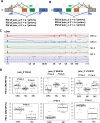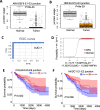Identification of novel alternative splicing isoform biomarkers and their association with overall survival in colorectal cancer
- PMID: 32503434
- PMCID: PMC7275609
- DOI: 10.1186/s12876-020-01288-x
Identification of novel alternative splicing isoform biomarkers and their association with overall survival in colorectal cancer
Abstract
Background: Alternative splicing (AS) is an important mechanism of regulating eukaryotic gene expression. Understanding the most common AS events in colorectal cancer (CRC) will help developing diagnostic, prognostic or therapeutic tools in CRC.
Methods: Publicly available RNA-seq data of 28 pairs of CRC and normal tissues and 18 pairs of metastatic and normal tissues were used to identify AS events using PSI and DEXSeq methods.
Result: The highly significant splicing events were used to search a database of The Cancer Genome Atlas (TCGA). We identified AS events in 9 genes in CRC (more inclusion of CLK1-E4, COL6A3-E6, CD44v8-10, alternative first exon regulation of ARHGEF9, CHEK1, HKDC1 and HNF4A) or metastasis (decrease of SERPINA1-E1a, CALD-E5b, E6). Except for CHEK1, all other 8 splicing events were confirmed by TCGA data with 382 CRC tumors and 51 normal controls. The combination of three splicing events was used to build a logistic regression model that can predict sample type (CRC or normal) with near perfect performance (AUC = 1). Two splicing events (COL6A3 and HKDC1) were found to be significantly associated with patient overall survival. The AS features of the 9 genes are highly consistent with previous reports and/or relevant to cancer biology.
Conclusions: The significant association of higher expression of the COL6A3 E5-E6 junction and HKDC1 E1-E2 with better overall survival was firstly reported. This study might be of significant value in the future biomarker, prognosis marker and therapeutics development of CRC.
Keywords: Alternative splicing (AS); Colorectal cancer (CRC); Metastasis; RNA-seq; TCGA.
Conflict of interest statement
The authors declare that they have no competing interests.
Figures





Similar articles
-
Profiles of alternative splicing in colorectal cancer and their clinical significance: A study based on large-scale sequencing data.EBioMedicine. 2018 Oct;36:183-195. doi: 10.1016/j.ebiom.2018.09.021. Epub 2018 Sep 19. EBioMedicine. 2018. PMID: 30243491 Free PMC article.
-
Novel prognostic alternative splicing events in colorectal Cancer: Impact on immune infiltration and therapy response.Int Immunopharmacol. 2024 Sep 30;139:112603. doi: 10.1016/j.intimp.2024.112603. Epub 2024 Jul 22. Int Immunopharmacol. 2024. PMID: 39043103
-
Distinct roles of programmed death ligand 1 alternative splicing isoforms in colorectal cancer.Cancer Sci. 2021 Jan;112(1):178-193. doi: 10.1111/cas.14690. Epub 2020 Nov 9. Cancer Sci. 2021. PMID: 33058325 Free PMC article.
-
Alternative splicing: An important regulatory mechanism in colorectal carcinoma.Mol Carcinog. 2021 Apr;60(4):279-293. doi: 10.1002/mc.23291. Epub 2021 Feb 25. Mol Carcinog. 2021. PMID: 33629774 Review.
-
Alternative spliced variants as biomarkers of colorectal cancer.Curr Drug Metab. 2011 Dec;12(10):966-74. doi: 10.2174/138920011798062355. Curr Drug Metab. 2011. PMID: 21787266 Review.
Cited by
-
Identification of the prognostic signature based on genomic instability-related alternative splicing in colorectal cancer and its regulatory network.Front Bioeng Biotechnol. 2022 Jul 18;10:841034. doi: 10.3389/fbioe.2022.841034. eCollection 2022. Front Bioeng Biotechnol. 2022. PMID: 35923577 Free PMC article.
-
Identification of an alternative splicing signature as an independent factor in colon cancer.BMC Cancer. 2020 Sep 22;20(1):904. doi: 10.1186/s12885-020-07419-7. BMC Cancer. 2020. PMID: 32962686 Free PMC article.
-
Alterations of RNA splicing patterns in esophagus squamous cell carcinoma.Cell Biosci. 2021 Feb 9;11(1):36. doi: 10.1186/s13578-021-00546-z. Cell Biosci. 2021. PMID: 33563334 Free PMC article.
-
Emerging role of caldesmon in cancer: A potential biomarker for colorectal cancer and other cancers.World J Gastrointest Oncol. 2022 Sep 15;14(9):1637-1653. doi: 10.4251/wjgo.v14.i9.1637. World J Gastrointest Oncol. 2022. PMID: 36187394 Free PMC article. Review.
-
PacBio Single-Molecule Long-Read Sequencing Provides New Light on the Complexity of Full-Length Transcripts in Cattle.Front Genet. 2021 Aug 30;12:664974. doi: 10.3389/fgene.2021.664974. eCollection 2021. Front Genet. 2021. PMID: 34527015 Free PMC article.
References
MeSH terms
Substances
Grants and funding
LinkOut - more resources
Full Text Sources
Other Literature Sources
Medical
Research Materials
Miscellaneous

